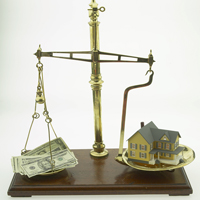|
 Consumers are often baffled by the home appraisal process. They may feel their home is worth a certain dollar amount, and therefore, the appraised value doesn't make sense to them. It is important to know that appraisal guidelines are dictated by the lenders. In many states, the lenders must disclose the purpose of the appraisal, as each situation carries its own set of rules. Consumers are often baffled by the home appraisal process. They may feel their home is worth a certain dollar amount, and therefore, the appraised value doesn't make sense to them. It is important to know that appraisal guidelines are dictated by the lenders. In many states, the lenders must disclose the purpose of the appraisal, as each situation carries its own set of rules.In essence, lender guidelines force appraisers to put a fair market value on a home based upon comparable sales in the area where the home is located, as the home must be bracketed according to size and value. For example, there is no set amount associated with a great view, pool, spa, bathroom upgrades, etc. If a homeowner installs a custom pool that cost them $30,000, and the local marketplace supports the value of a pool at $15,000, that item will be bracketed as [$15,000] on the appraisal. Upgrades can usually be expressed at full value in newer homes since they required investing additional money onto the cost of building the home. On the other hand, the amount invested in upgrading or remodeling an older home is rarely reflected in full in the final appraisal. The reason is the home had value in its original condition, and again, the value of the upgrades must be supported by comparable examples within the same marketplace. These comparisons must be drawn from current market activity within the last six months. Some lenders may want to look at both closed and pending sales to see if there is any room for negotiation. This is a safeguard to prevent appraisers from over-valuing the home in question. It is further stated in the guidelines that appraisers can only place a value on homes that have closed escrow. However, when property values rapidly increase within a marketplace, appraisers are generally permitted to make concessions and put more weight on the evidence provided by comparisons to pending sales and listings. This allows for a "real time" appraisal. Although there is no formal standard to speak of, most lenders give the appraiser a 5% margin of error. If the file is reviewed and the appraiser is off by 8%, there is a good chance the value will be cut by the full 8%. It is in the best interest of both the appraiser and the homeowner not to push the value up higher than the market will support, otherwise the property evaluation may be exposed to a strict appraisal review. As a loan executive, I make it a point to follow lender guidelines at all times, and work within the systems they provide. This promotes a good relationship with the lender, and smooth closure for my borrowers. As always, you are welcome to contact me if you have any questions. Call me directly for a free consultation. |
|
|
Moorestown, NJ
Accredited Loan Consultant
Marlene - Thanks for stopping by. I'm glad to hear that my info helped. If there are any other mortgage related items you'd like to know more about, just let me know and I'll be happy to share.
Sep 19, 2008 04:44 AM


Comments(2)